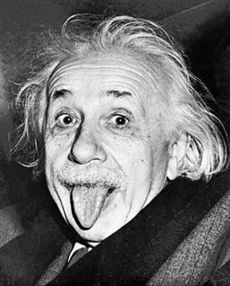
1/ How about's a non-political thread 🧵about science! I mentioned PSR B1913+16 earlier today. Let's chat about it.
2/ Gravity is the ultimate fiend of the universe. It will cause anything to collapse if it doesn't fight. Stars stave off that collapse by fusing hydrogen into helium in their cores. Mass is converted into energy and that allows the star to resist the inward pressure of gravity.
3/ Eventually, however, a star will run out of core hydrogen and try to fuse heavier elements. This holds off gravity, but not for long. Stars like the Sun stop at fusing helium into carbon and oxygen. Giant stars like Betelgeuse get carried away and go all the way to iron. 

4/ As the star fuses heavier elements, the energy payoff diminishes. When it tries to fuse iron, it *loses* energy. The result is that the core of the star implodes. The shockwave blows the outer layers of the star away. This is a supernova and it can outshine an entire galaxy.
5/ The shriveled remnant of the star's core weights 1.4 times that of the Sun, is the size of a small town and spins anywhere up to hundreds of times a second. It is a neutron star, held up against gravity by quantum mechanics.
6/ Neutron stars have powerful magnetic fields -- like up to a quadrillion times more powerful than Earth's. If you stood on one, you'd be crushed to an atom thick by the gravity and any metal would be ripped apart by the magnetic field. 

7/ Neutron stars are too tiny to give off conventional light. But those magnetic poles give off radio light. If the neutron star's pole is oriented toward Earth, you will see flashes of light as it spins, like a lighthouse. This is called a pulsar. 

8/ Pulsars were discovered in 1967 by Dame Jocelyn Bell-Burnell. The discovery won a Nobel Prize ... for her advisor. She's always been gracious about it. She's one of the better people in our profession; a living legend who kind of lives up to the legend. 

9/ The pulsar's spin is extremely regular the signals we received from them are extremely regular. This makes them useful tools. In 1974, Joe Taylor and Russell Hulse were doing a survey of pulsars using the Arecibo radio telescope. They noticed one pulsar was acting ... strange. 

10/ The period between its pulses was changing. At first, they couldn't figure out what was going on. Pulsars periods are not supposed to change. But then they realized the pulsar must be in a binary system, orbiting another star.
11/ Most stars in the universe are not singletons. They start out as multiples. In this case, two stars that had gone supernova, leaving those shriveled crazy neutron stars orbiting each other. The change in the pulses was because PSR B1913+16 was orbiting another neutron star.
12/ I once saw Bell-Burnell give a talk on this. She demonstrated the effect by setting off an alarm clock and swinging it over her head by the power cord so we could hear the change in pitch from the doppler effect.
Told 'ya she was cool.
Told 'ya she was cool.
13/ This is where my undergraduate advisor, Joel Weisberg, comes in. He and Joe realized that this pulsar could be used to test Einstein's General Theory of Relativity.
14/ General relativity predicts that two compact massive objects orbiting each other will lose energy by creating gravitational wave -- ripples in the fabric of spacetime itself. The loss of energy causes the two objects to spiral in toward each other.
15/ If this were true, the orbital of PSR B1913+16 should be getting shorter over time. By very tiny amounts. But remember, those pulsar signals are *extremely* regular. Even a small change in orbit would be detectable.
16/ They monitored PSR B1913+16 for a couple of decades. That 7.75 hour orbit of the pulsar shrunk by 20 second, exactly as predicted by Einstein's equations. 

17/ Joel was my prof, advisor and friend (and still is) and he once gave us an exam question to calculate the upper limit on any changes in the gravitational constant of the universe using the pulsar data. Einstein's equations predicted the behavior to within 0.3% +- 0.2%.
18/ In 1993, Taylor and Hulse won the Nobel prize. Not for the gravitational wave work, but for the discovery. In the ensuing 25 years, PSR B1913+16 has continued to behave as if Einstein was right. Because he was. Albert was always right. 

19/ There is one more thing. When two black holes or two neutrons stars finally spiral in to merge, they release a gigantic amount of energy and gravitational waves so intense, they can be detected millions of light years away. In 2017, LIGO was looking for these waves.
20/ On August 17, 2017, it detected the collision of two neutrons stars. Every telescope on Earth started scanning the sky and eventually we found the fading light from that explosion. The first time a gravitational wave source was detected in light. en.wikipedia.org/wiki/GW170817 

21/ I was part of that giant collaboration of thousands of physicists and astronomers. It was the most intensively studied event in human history. And we learned so much from it.
22/ One of the things we learned: elements are forged in astronomical events. When the universe was young, it consisted of hydrogen and helium. Everything else was forged in supernova explosions, stellar winds, nebulae, cosmic rays, etc.
23/ From this event, we learned that many elements are formed in neutron star collisions. One of those elements is gold. So one day, that binary pulsar were merge. And the explosion will form gold. Exactly like the gold that Taylor and Hulse were given for discovering it. /Fin 

• • •
Missing some Tweet in this thread? You can try to
force a refresh


